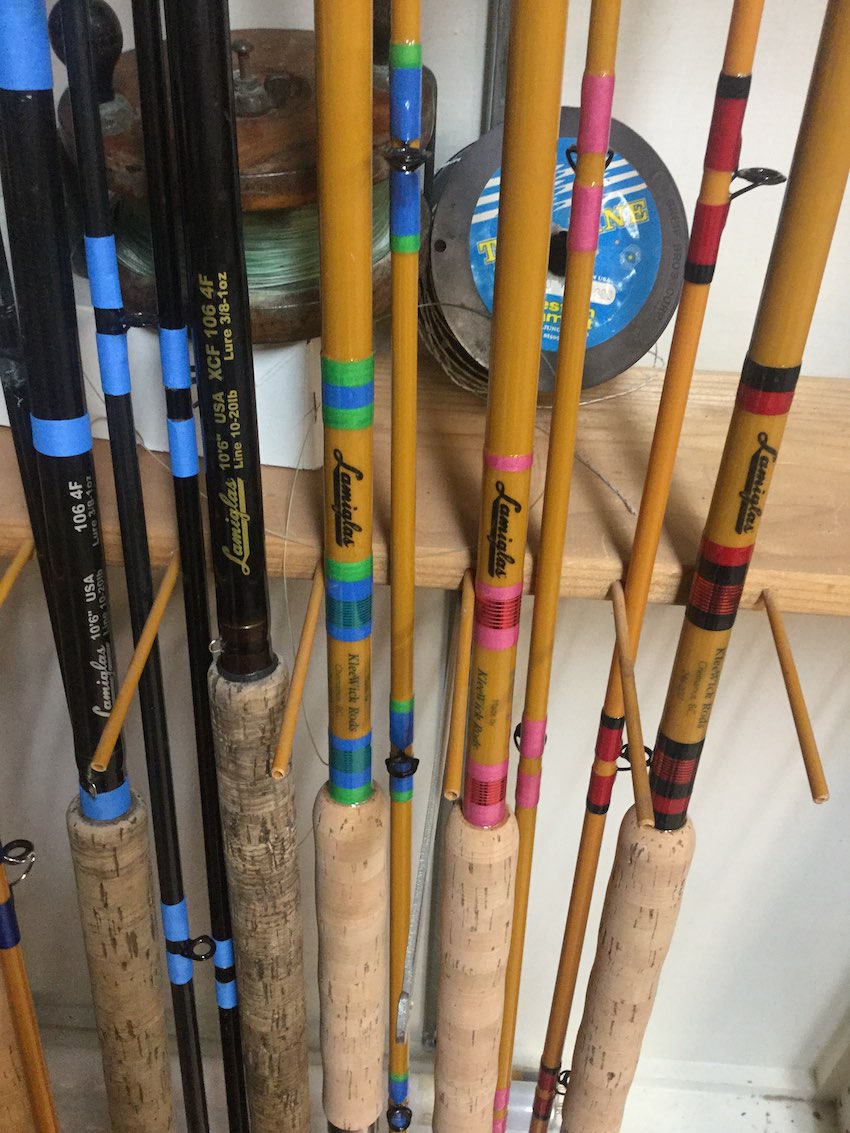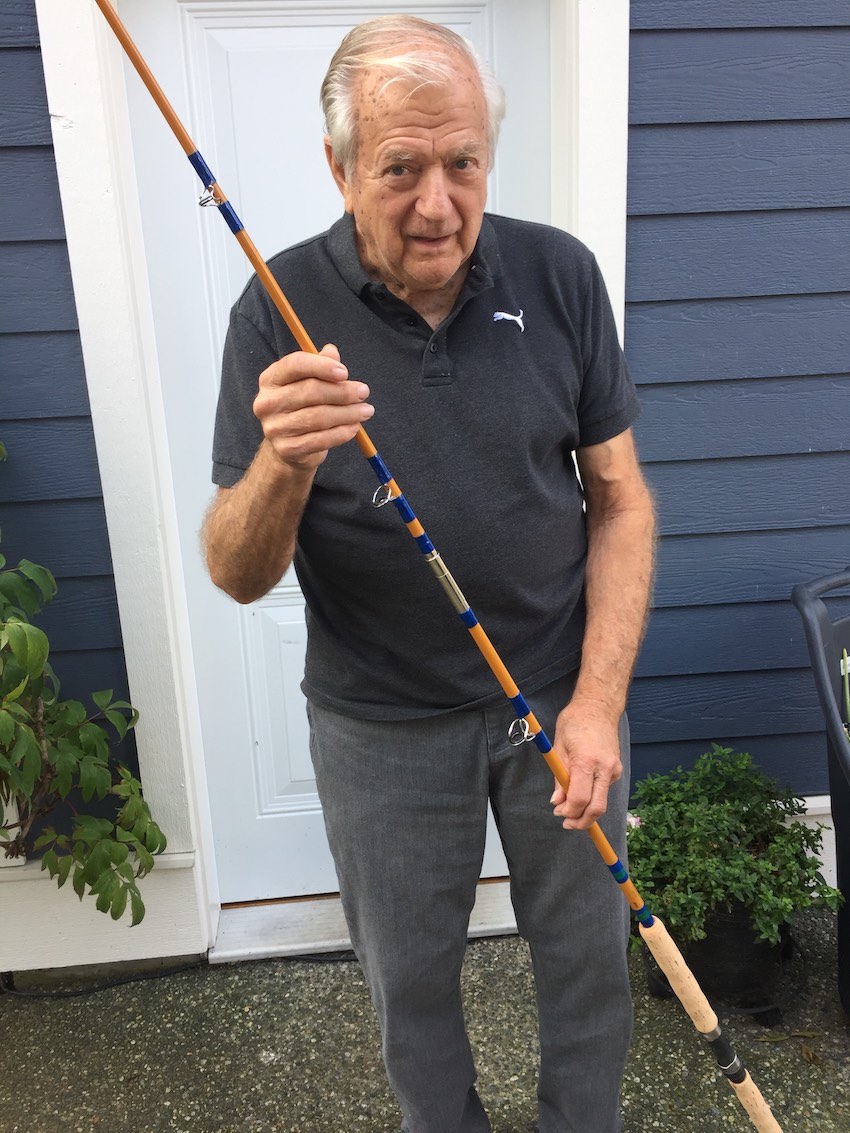Vancouver Island Fishing Gear Manufacturing
Vancouver Island has long been home to many great fishing gear innovators and manufacturers. The need for rugged and effective sport fishing gear has grown with the sport fishing industry. Some of the products are simple and utilitarian, while others are closer to works of art. Occasionally, they can be both. Michael Wickstrom has achieved this with the simple, but beautiful, custom fishing rods he has been making on Vancouver Island for almost fifty years. Better known as KleeWick, after the Coast Salish word for “the smiling one,” he has become a part of the history of sport fishing on Vancouver Island.

Early Years at Peetz
A 15-year-old KleeWick entered the tackle manufacturing industry around 1955, when a friend suggested he join him pouring lead for fishing weights at Peetz in Victoria. While pouring molten lead might seem like an unlikely job for a teen today, this type of hard labour was not unusual for youngsters at that time. These were the early days of sport trolling for salmon. Previously most fishing had been done by net or hand line, along with some fly fishing. However, a Victoria-based goldsmith named Boris Peetz had begun making wooden fishing reels for himself. Soon he was getting requests from other local fishermen to build reels for them. Eventually, this grew into a thriving fishing tackle manufacturing business that continues to the present day as Peetz Outdoors Ltd.
As demand for the venerable Peetz mooching reel began to grow, young KleeWick moved up in the company from pouring lead into producing the reels themselves. At that time, everything was done by hand. He cut out the brass arbors for the reels and then turned the leftover bits of brass into reel handles and other small internal components. Eventually, Peetz got a hand press to punch out the components, and KleeWick moved onto the lathe turning out the wooden reels. He spent the next 10 years turning reels as the demand for trolling reels for sports fishermen increased. Around 1977, Ivan Peetz (son of Boris) informed KleeWick that he had been producing 10,000 reels a year for 10 years. Therefore, there are at least 100,000 Peetz reels out there that were handmade by KleeWick.
Rod Building
At the same time, KleeWick began working on Peetz fishing rods at home after his regular shift turning reels. This proved a successful way to generate more income and would eventually lead to his later career in custom rod work. By this time, he had married and had children. He got his children and even his wife involved in making the rods, turning it into a family business.

During this time, KleeWick was living and raising his family in Victoria. He used the free time he had available for salmon fishing in local waters. Ivan Peetz kept a 14′ boat on Gonzales Bay that KleeWick could use. One day while heading out fishing in it, he saw what looked like about twenty boats around Trial Island. Assuming they were fishing boats that had found the fish, he headed in that direction. When he got there, they had all disappeared. His was the only boat around. This was before the advent of large outboard engines, so there was no way they could have moved out of sight that quickly. Despite this unsettling occurrence, he decided to get his fishing gear ready anyway and busied himself with that. Suddenly, about twenty Orca dorsal fins broke the surface all around him. He realized these were the “boats” he had seen in the distance. He was surrounded and jostled by many energetic Orca, all larger and faster than his boat. While many people today would be thrilled, at this time most people were very unsure about Orcas, and nobody knew if they were a threat to humans—especially humans in small wooden fishing boats. KleeWick decided not to find out, and as the fishing was probably shot anyway, he left the area.
Peetz Sold in 1978
He worked at Peetz until 1978 when the company was sold. After 22 years, KleeWick decided to make a change and start his own rod construction business. He began producing his own custom rods based on Lamiglas blanks. This caused some friction with Peetz, as the colour of the threads he was using was the same as that used by his former employer. So he simply found different coloured thread—issue solved.

To this day, he uses the same techniques and Lamiglas blanks to build his custom rods. He says that while graphite rods may be more sensitive, the durability of Lamiglas is unparalleled. His rods gained in popularity, and soon he began wholesaling them to major retailers such as Eaton’s and Woodward’s. At the same time, fishing techniques were changing. Fishermen were moving away from heavy trolling rods and towards lighter mooching rods. With the advent of downriggers, mooching rods became the mainstay of Vancouver Island fishing. In about 1983, he began making light cork-butted rods instead of heavy wood ones. And while mooching rods were KleeWick’s primary business, he also started making spin casting, halibut, and fly rods.
KleeWick Today

With his building style fully mature, KleeWick settled down to a long career of custom rod building. He has moved his business from Victoria to Cowichan and has now relocated to Lantzville, with his newest workshop nearing completion. Today, fishermen from all over the world continue to use and order custom KleeWick rods. It takes approximately 3 to 4 days of work for him to turn out one of his standard rods, and each one is built to the customer’s specifications and colour choices.
Every rod is unique, and hand signed by KleeWick. They stand apart from the mass-produced import rods commonly seen today. Very few rod builders still maintain this traditional rod construction technique. It’s safe to say that rugged KleeWick rods will be in use for many decades to come, putting fish in the boat, and smiles on fishermen’s faces. What else would you expect from a man nicknamed “the smiling one?”
Mike can be reached at 1-250-390-494, [email protected] or visit his Facebook page.
This article appeared in Island Fisherman Magazine. Never miss another issue—subscribe today!







I have used one of his fishing rods for about 7 years now and it is excellent. When I damaged the rod I took back to him and it was repaired like new and the service was excellent.
The rod I have is a lot of fun when a big spring hits and it very well balanced.
I would highly recommend his rods and his work is excellent.